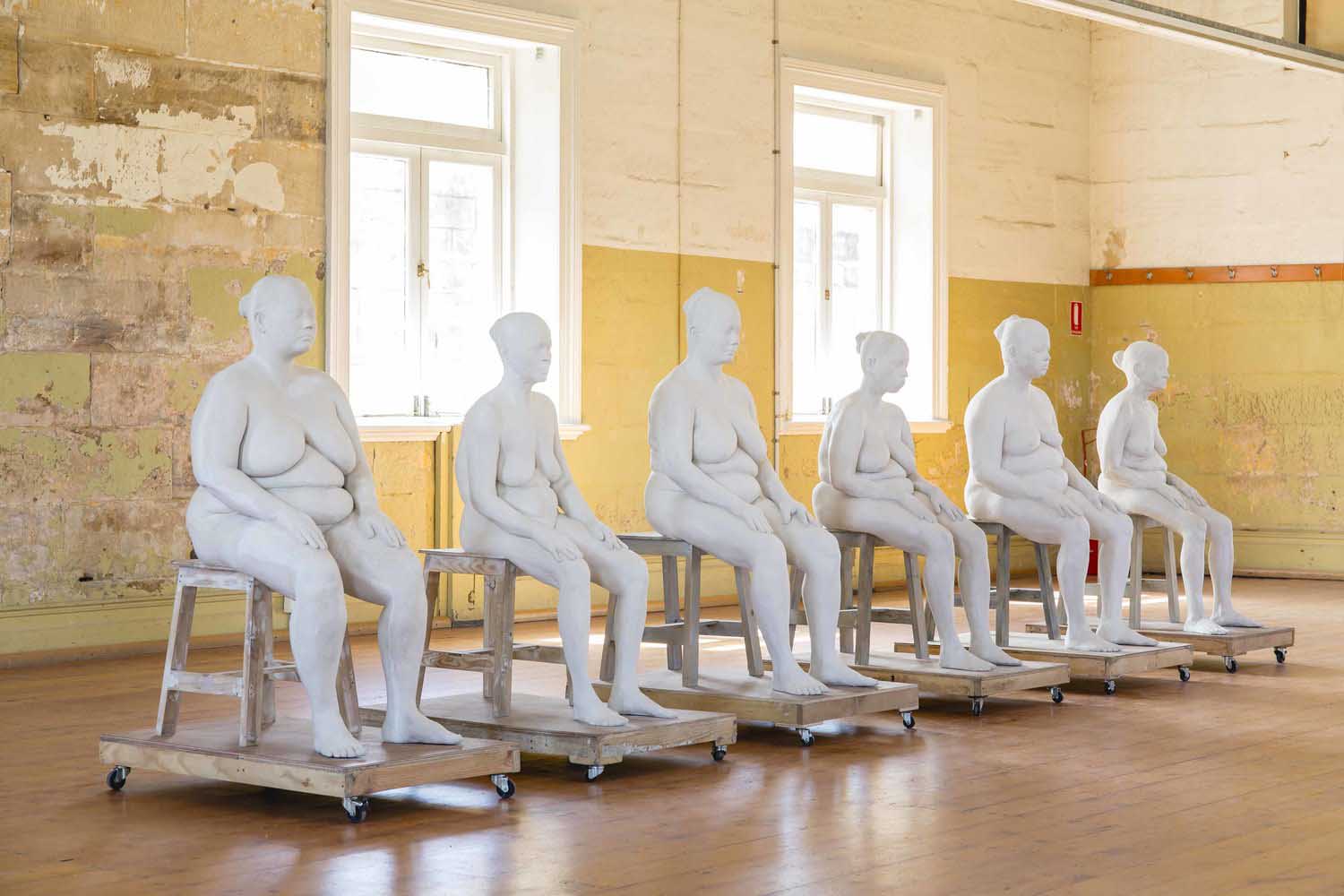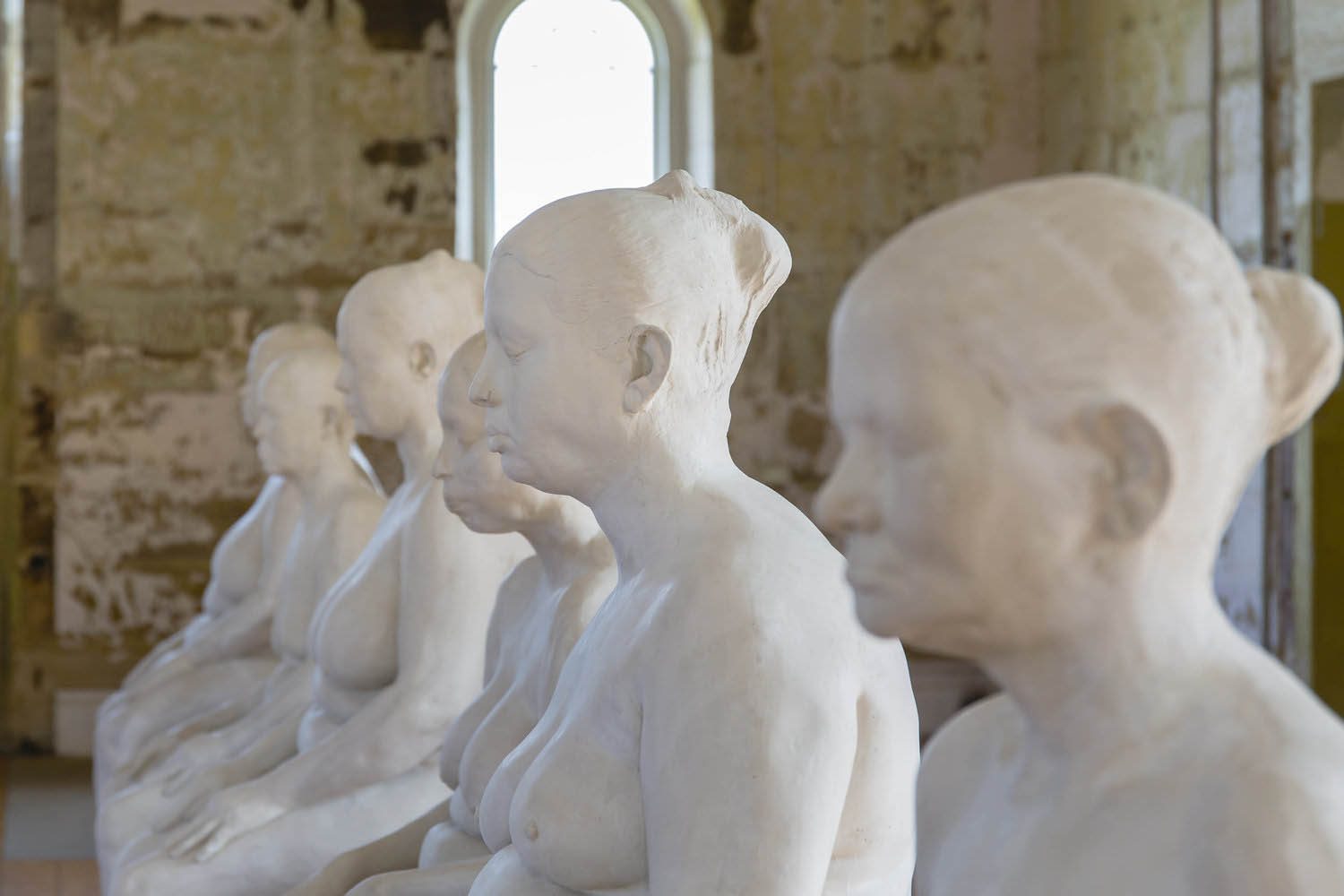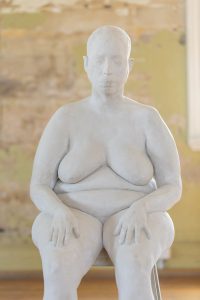For anyone familiar with Bharti Kher’s oeuvre, this work comes as a surprise. They sit there—eyes closed, hands on their thighs, feet on the floor. There is no allusion to a presence. No sari that has been undraped. No shoes that have been stepped out of. They are here with us in this moment. They have no antlers, no horse hoofs, no dog heads. They are whole. They are not poised to pounce, they do not strike warrior poses. They are ground-ed. The title of the work does not invite the imagination to roam. Instead, it centres it. With Six Women (2014), we are in a brave new space with Bharti Kher. She has been headed here from the start.

Bharti Kher
Six Women
2014. Plaster of paris, wood, metal. Dimensions variable.
Installation view at Cockatoo Island for the 20th Biennale of Sydney 2016.
Photography: Document Photography.
If there is a form most strongly associated with Kher’s work, it is the dot. In material form, Kher’s dots are bindis. The bindi rests, on the forehead, on the third eye, a channel into the energy of universal consciousness. In dense patterns, sometimes symmetrical, sometimes swirling, the bindis in Kher’s work are at once the energy of colliding black holes and of dividing cells. They are the sand dunes shifting with the wind, and also the churning waters of the ocean. The bindis move across dimensions of space, on mirrors and maps, and in time, on charts of the inception and growth of life in the womb.1 They are the pumping sinews of the whale heart.2 This energy pulsates through Kher’s other works—it is the vibration that stills the globes mid-rotation, that suspends the wooden triangles in balance.3 You can feel the force, especially when it departs. In the Pachyderm, as it collapses—its front legs buckling first, its trunk next, and finally its posterior, as it gazes at us with its eyes barely open.4 In the conch-holding Dead ruler as she tips back on her chair.5 Stars, we now know, shine brightest just before they explode. This is the explosion. It is the Big Bang. It is the most intense burst of energy from which the universe unfolds. It is also a moment of silence.
The women are prostitutes. I know this only because the artist told me so. I was standing naked before her. The sun streamed into the Renzo Piano-designed flat that she occupied as artist-in-residence at the Isabella Stewart Gardner Museum in Boston. Her hands were sweeping over, caressing my breasts and pregnant belly. The newspapers that she had painstakingly laid out on the floor below us were streaked white. Bharti worked quickly—scooping up the plaster and smearing it against my skin in a clean arc. I was surprised by how pleasant, even comforting, the process was. A ritual readying for the violence that was to be wrought on my body.

“They are from Sonagachi,” she said.
The cadence of her voice punctuated the arc of her movements. I noticed the beads of sweat that dotted her brow.
“I’ve never cast prostitutes before.” And then, more to herself than to me, she added, “It’s going to be the same as all the other women I have cast. Just the same.”
Kher visited the maze of row houses that is the infamous red-light district of Sonagachi in Kolkata. She chose the women. They travelled to her studio for the casting. At the end of the day, she paid them. Kher’s diary reveals her own dis- comfiture with the process.
MAY 6, 2012
What then makes me different from the client…in this and most cases the man? Does my empathy count for anything? Does my work as an artist give validity to the role I play in this circus of meaning?
DECEMBER 8, 2012
So I go to meet 12 women (eventually only six were cast) and the art was the only thing that carried me that day in smoggy Calcutta… I was constantly aware of my privilege… Of questions that I’m unable to answer. Why is my art even important to someone who needs money and that’s why they give me their body. Is it important that they acknowledge my intention so I feel justified? Is my justification reason enough to go through with this.
FEBRUARY 14, 2014
The first castings have begun. It was a cold rainy morning. We met each other rather nervously… I found this socially awkward and didn’t want to appear like a rich exploitative zamindar calling in the chosen ones. How I think so filmy and like a man even surprises me sometimes.
And yet Six Women is as much of a challenge to boundaries and ascribed feminine categories as any of Kher’s other works. In the Hybrid series, Kher transforms women portrayed with objects that might signal domestic drudgery (a vacuum cleaner, a young child, dishes) into angels, hunters, part-female, part-feline, part-simian. Kher has recalled what a painstaking process it was to transform those photos in the days before Photo-shop. Here, through the simple but critical act of naming—Six Women—she closes a chasm, bringing together women who accept money for the provision of sexual pleasure with women who have not entered into such an exchange.
The exchange of money for the body— this has been the basis for one of the oldest and most profound separations of women. This categorical divide has existed and been strenuously maintained, especially by men, since the historically traceable beginnings of prostitution itself. The Kama Sutra matter-of-factly differentiates women into those who seek for love and those who seek for money. In other places and times—for example, Victorian England—the differentiation has been accompanied by far more judgment, signifying a divide between moral and immoral, chastity and indecency, honour and shame, even good and evil. The closing of this separation has historically been a source of much anxiety. Nineteenth-century Paris was a time of unprecedented prominence of the prostitute in the public life of the city. Paul de Saint- Victor wrote in 1870: “Courtesans exist in all times and places… But has there ever been an epoch where they made the noise and held the place they have usurped in the last few years? They figured in novels, appeared on stage, reigned in the Bois [de Boulogne], at the races, at the theatre, everywhere crowds gathered.”6 But it was less the prominence of prostitutes and more the air of ambiguity in public places, with society women and prostitutes mingling during daylight hours, that was a cause of unease. The press of the time complained that you couldn’t distinguish an “honest” woman from a harlot, in no small part because society women imitated the manners and customs and dress of prostitutes, who defined the fashion trends of the time. Kher has shown herself to be adept at the blurring of boundaries—object, animal, human, divine—through material mutation. In Six Women, the challenge is more subtle and yet more powerful. It is a challenge through what Pierre Bourdieu famously termed the “act of naming.” By choosing to call them “women,” Kher takes away society’s symbolic power to name and separate them as prostitutes.
It is, to be sure, a very different challenge from that of contemporary performance artists such as Andrea Fraser who seek to reclaim and redefine the body of the sex worker through acts of prostitution. One might see it as a challenge closer to the defiance that Édouard Manet famously painted into the gaze of Olympia (1863) that so stunned the Paris Salon of 1865. And yet it is a challenge that resonates with the voice of the prostitutes of Sonagachi, in the brief flickers when they can be heard, challenging their exclusion from Kolkata’s respectable, or bhadra, society and from the labour force. For instance, as a sex worker in Tales of the Night Fairies (2002), Shohini Ghosh and Sabeena Gadihoke’s powerful film about Sonagachi, puts it:
I now cannot make a distinction between my mother and myself. My mother also did sex work. She slept with my father to feed and clothe her children. I do exactly the same work but take money in exchange. With that money I also feed and clothe my children. So how is the sex worker so different from the housewife? That’s why I don’t understand why sex work carries such stigma.
Inasmuch as Kher closes a societal boun-
dary with Six Women, she also transcends a division in the history of art. Artistic representations of prostitutes have tended to fall into, or at least lean towards, one of two poles: glamour or wretched- ness. This dichotomy is captured nicely by the title of the Musée d’Orsay’s recent exhibition Splendour and Misery: Pictures of Prostitution, 1850–1910, the first major exhibition to examine the prostitute’s central role in the public life and art of that time. It showed, on the one hand, depictions of infamous Parisian courtesans, such as La Païva or Valtesse de la Bigne, who were gifted with jewels, clothing and luxurious mansions (cash payments were considered vulgar), along with images of “happy hookers,” shown lifting a skirt to reveal a glimpse of an ankle boot and casting a furtive look. On the other hand were portrayals of prostitutes as society’s victims. The typical prostitute in late nineteenth- century Paris was, in fact, a young migrant who worked full-time or part-time (often supplementing a meagre income as a florist, a domestic maidservant or needleworker) either in a brothel or walking the streets. She was classified, counted and con-trolled by a citywide, police-administered system. Any woman suspected of selling sex was forced to register as a prostitute—a classification that essentially remained in place for the rest of her life. Constables regularly harassed and arrested street-walkers. By far the most humiliating aspect of the regulatory system, however, was the mandatory medical inspections instituted by a state terrified of syphilis, which saw the bodies of prostitutes as sites of infection but allowed male customers to continue to transmit the disease to their wives and other women. In his Salon de la rue des Moulins (c. 1894), Henri de Toulouse-Lautrec captures this “abominable visit which will prevent her rising even the smallest bit above the worst vulgarity.”7 The residents of the rue des Moulins queue in blouses and stockings but no underwear, waiting for police surgeons to thrust cold, unsanitary speculums into them. Those suspected of being infected with venereal disease were locked up in prison-hospitals such as Saint-Lazare, the subject of many of Pablo Picasso’s paintings during his Blue Period.
With Six Women there is neither fear nor fascination, neither desire nor repulsion, nor pity or even empathy. There is no social commentary; no commitment to document. Intent falls away entirely, and the residue is pure intuition. Kher is no stranger to casting. It has been central to her craft. The plaster skins piled high in every corner of her studio carry the memory of what Kher calls the “strange catharsis” of the process.
Kher is, in particular, no stranger to casting the bodies of women. The body of the prostitute is also historically no stranger to being painted or cast. Yet in both Kher’s earlier work and the history of art, such bodies have tended to be cast into grander visions. Kher’s women have become Arione and her sister; Titian painted Venice’s highest-paid courtesan of the time, Angela del Moro, as Venus; Auguste Clésinger cast Apollonie Sabatier, the favourite courtesan of Eugène Delacroix, Gustave Flaubert and Charles Baudelaire, in a reclining celestial pose recoiling from a bite by a serpent.8 But the women of Sonagachi are neither mythic nor sacred nor profane. In facilitating their appearance, Kher makes it possible for them to inhabit and transcend their corporeal form. Six Women is composed of the plaster casts of the naked bodies of six women whose identity has been defined by a commercial exchange that involves the body. Yet this work is not about the body.

In modern science, bodily existence is seen as a necessary condition for consciousness. In many older traditions of thought, however, including the Indian medical system of Ayurveda, consciousness exists prior to and beyond the body. Consciousness itself is the phenomenon that gives rise to thought. But Kher’s women are not thinkers. They are in the centre of awareness. Through their meditation, their objective, physical awareness has been absorbed into the subjective presence, into pure existence. Women are said to fall into prostitution. Kher’s women, however, have neither fallen nor risen.
In an article on Delacroix, Baudelaire wrote that “the most obviously characteristic features of Delacroix’s style are conciseness, and a kind of in-tensity without ostentation, the usual type of thing arising from concentrating the whole of one’s spiritual power on a given point.”9 This is the zone that Kher’s practice moves into. “The hero,” Baudelaire goes on, quoting Ralph Waldo Emerson, “is he who is immovably centred.” The same line serves as the epigraph for Rainer Maria Rilke’s famous mono-graph on Auguste Rodin: “The hero is he who is immovably centred.”10 These words, sans the epithet “hero,” could equally be applied to Six Women.
In yogic theory, a cosmic energy lies coiled at the base of the spine. The awakening of this energy, and its ascent up the chakras of the spine, is the basis for spiritual realization. In most yogic texts this libidinal force (the kundalini) moves up the channels, until it finally reaches the crown chakra, the Sahasrara. In tantric yoga, however, the critical energy centre, where the mind dissolves into the universal consciousness, is the bindu, the dot. Kher’s six women in line connect her dots.
This essay by Prerna Singh was first published in Bharti Kher: The Trick is Living, 1:55-65.
New Delhi: Nature Morte Art Limited, 2022
ISBN: 978-91-956749-1-6
Edited by Aveek Sen
Designed by Rukminee Guha Thakurta/ Letterpress Design Studio
Artist’s Bio:
Bharti Kher (b. 1969) was born in London and majored in Painting, Fine Arts BA, from the Newcastle Polytechnic in the UK. Her art gives form to quotidian life and its daily rituals in a way that reassesses and transforms their meaning, with her own personal language of alchemy and mythology. Her use of found objects is informed by her own position as an artist located between geographic and social milieus. Amongst Kher’s signature materials, loaded with symbolism is the bindi, which first appeared in her work in 1995. Kher’s recent solo exhibitions include: ‘A consummate Joy’, Irish Museum of Modern Art (2020); ‘Chimeras’, Centre Pasqu’Art, Biel (2018); ‘Dark Matter’, Museum Frieder Burda, Berlin, (2017). Recent group exhibitions include: ‘Tantra: Enlightenment to Revolution’, British Museum (2020); ‘Contemporary Female Identities in the Global South’, Johannesburg Contemporary Art Foundation (2020); ‘Desire: A revision from the 20th Century to the Digital Age’, Irish Museum of Modern Art (2019); ‘Surface Work’, Victoria Miro, London (2018); ‘Like Life: Sculpture, Colour and the Body (1300-Now)’, The Metropolitan Museum, New York (2018). In 2022, Ancestor, an 18-foot-tall bronze sculpture commissioned by Public Art Fund was unveiled in New York. Kher’s works are in the collections of the Tate and the British Museum in the UK; the National Museum of Canada; the Guggenheim Abu Dhabi; the Walker Art Center and the North Carolina Museum of Art in the US, amongst others.
Prerna Singh is Mahatma Gandhi Associate Professor of Political Science and International Studies, with appointments in the School of Public Health and the Department of Sociology at Brown University. She has published numerous award-winning books and articles on human development, public health, ethnicity and nationalism. Her first book, How Solidarity Works for Welfare was awarded best book prizes from both the American Political Science and the American Sociological Associations. Singh has been awarded fellowships by the Center for Advanced Study of Behavioral Sciences at Stanford University, the Social Science Research Council, the Rockefeller foundation, the Andrew Carnegie foundation, the American Academy of Berlin, the Canadian Institute for Advanced Research (CIFAR), the Harvard Academy for International and Area Studies, and the American Institute of Indian Studies. She has shared her research with scholarly, policy and popular audiences in over a hundred lectures, including keynote addresses, delivered across twenty different countries. Singh serves on the academic advisory board of the Harvard-Yenching Institute, the steering committee of the Center for Contemporary South Asia at Brown, is a fellow of the Canadian Institute for Advanced Research and co-convenes the Brown-Harvard-MIT Joint Seminar in South Asian Politics. She serves on the editorial board of Cambridge University Press’s Studies in Comparative Politics as well as the Elements in the Politics of Development series. From 2021-23, Singh served as President of the Comparative Politics section, the largest section of the American Political Science Association. She is presently working on a book manuscript ‘Moral Vaccination: Ideas and Institutions in the Control of Contagion in China and India’. She is also working on a range of projects around identity politics, ethnicity and nationalism, specially in India. Singh also writes for popular media outlets including the LA Times, the Washington Post’s Monkey Cage blog and Indian outlets such as the Times of India and Seminar. She has studied at Princeton, Cambridge and Delhi Universities. Prior to joining Brown, she was on the faculty of the Department of Government at Harvard University.

Subscribe to our newsletter To Recieve Updates
Join our newsletter to receive updates